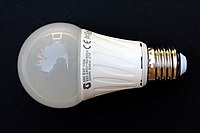
Photo from wikipedia
Tuning the electrochemiluminescence (ECL) wavelength of carbon dots (CDs) with enhanced efficiency is essential for multiplexed biosensing, bioimaging, and energy applications but remains challenging. Herein, we reported a facile route… Click to show full abstract
Tuning the electrochemiluminescence (ECL) wavelength of carbon dots (CDs) with enhanced efficiency is essential for multiplexed biosensing, bioimaging, and energy applications but remains challenging. Herein, we reported a facile route to finely modulate the ECL wavelength of CDs from 425 to 645 nm, the widest range ever reported, along with a more than 5-fold enhancement of ECL efficiency via phosphorous (P) incorporation. The molecular mechanism was explored experimentally and theoretically, which revealed the unusual dual roles of P dopants in the form of P-C and P-O bonding, that is, importing shallow trapping states and promoting an effective intramolecular charge transfer. This work would allow unlocking the key factors of ECL kinetics for heteroatom-doped CDs appearing out of reach and open a new avenue for the rational design of nanocarbon for desirable applications.
Journal Title: Analytical chemistry
Year Published: 2022
Link to full text (if available)
Share on Social Media: Sign Up to like & get
recommendations!